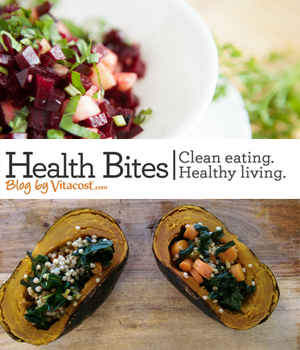Healthy Tips From Vitacost: Organic Shopping 101
We hear about Organic foods a lot these days and it can be confusing when to spend a little extra and what you are really getting for your hard earned cash. Vitacost.com sent me an excellent guest post to share with you the 411 on how to decipher organics when you’re filling your cart to feed yourself and family. Thank you Vitacost!!
By: +Elizabeth Lotts writer for Vitacost.com
The organic versus non-organic decision is still a cart-stopper in the grocery store. Which fruits are healthier when grown organically? Which vegetables? What about that box of crackers? Trying to pick the cream of the crop becomes a chore within a chore when you don’t know the ”why” and “what” factors. All you need is a quick, Organic Shopping 101 course to narrow the selection and get you to the check-out line in record time.
First, determine why you are shopping organic so your selection doesn’t feel so fruitless. If you need to justify (to yourself or your budget-conscious significant other) why you’re spending a little more on certain items, then consider these reasons:
- Organic means farmers use no antibiotics and no growth hormones, grow produce within sanitary and spacious facilities and use the fewest conventional pesticides
- No GMOs– organic foods are not genetically modified in any way
- A smaller carbon footprint–organic farms use the most sustainable methods to promote biodiversity and a healthy eco-system
- Cleaner water, soil and air–pesticides from conventional farming can intoxicate the water supply, wildlife and the atmosphere
If these reasons don’t inspire you to go organic for every single purchase, consider that it doesn’t have to be an all-or-nothing situation. Just keep in mind that certain conventional fruits and veggies are produced with a high number of pesticides– these, you should buy organic.
Fruit:
– Apples
– Any berries (strawberries, blueberries, raspberries, etc.)
– Nectarines
– Peaches
– Pears
– Cherries
– Grapes (imported variety)
Veggies:
– Leafy greens (spinach, kale, lettuce)
– Bell peppers
– Carrots
– Celery
Meat, eggs and dairy: The organic options ensure animals are provided healthy living conditions, organic feed and adequate treatment for injuries or illness. When buying organic in the refrigerated aisles, select “all of the above.”
Crackers, cookies, cereals, coffee and anything else in a box or bag: This is an open-ended question, which means you can pick and choose which of these are better organic based on your preferences of taste, brand, price and/or variety. The same rules apply, though: organic cereals must contain all organic ingredients. If your mixed berry granola claims it’s organic, then it was made with organic berries. (Hint: buy only as much as you need. Packaged goods usually find a place in the pantry for many months, but organic versions have a shorter shelf-life due to their lack of artificial preservatives.)
Your final exam: Make your shopping list and match the items on it with the groceries above. If you study the organic foods and brands you prefer, then you won’t second-guess yourself!
This article has been provided by the folks at Vitacost.com who has been selling discount vitamins since 1994. They have grown into one of the biggest online marketplaces for healthy living essentials-with vitamins and supplements being just one of their many helpful categories! They sell everything from Coq10 to Raspberry Ketones. Vitacost.com’s customers mean the world to them, and it’s their goal to provide you with the best nutritional supplements, health foods and sports nutrition toarticles on the benefits of probiotics. Be sure to check out Vitacost Coupons for discounts. Vitacost.com is not affiliated with this blog, and isn’t responsible for content outside of this article.


